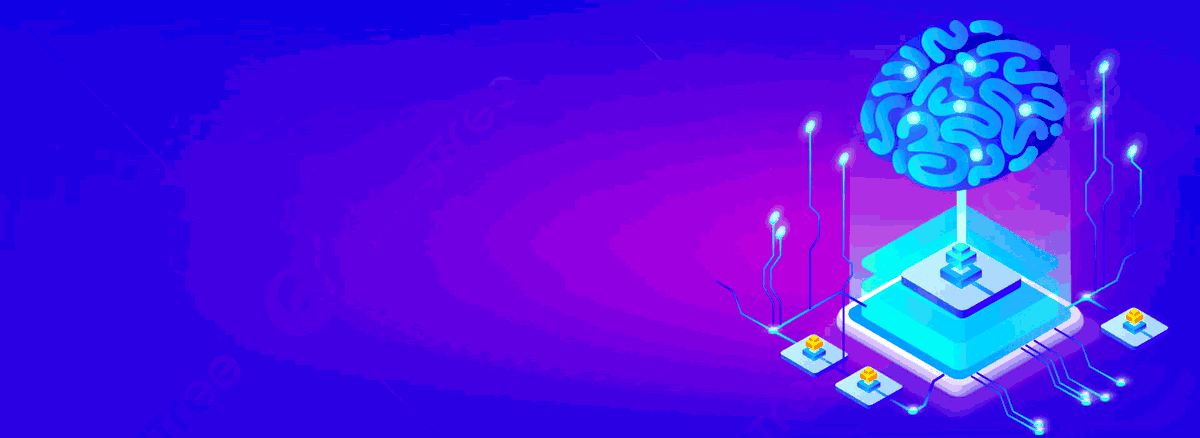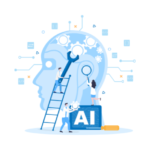 How Does Generative AI Work? It bridges human creativity and machine learning, crafting art, text, and music with unprecedented innovation.
How Does Generative AI Work? It bridges human creativity and machine learning, crafting art, text, and music with unprecedented innovation.
Generative AI represents one of the most transformational and talked-about technologies emerging today. But how does this futuristic AI actually work under the hood?
In this post, we’ll dive deep into the key concepts, training processes, architectures, and capabilities that enable generative models to produce their stunning outputs.
What Exactly is Generative AI?
First, let’s clearly define what we mean by generative AI. As an AI practitioner, I think of generative AI as a category of machine learning systems with an almost magical ability to autonomously synthesize brand new content and artifacts.
Unlike most AI today which focuses on analyzing existing data, generative AI allows computers to produce completely novel, original outputs including text, images, audio, 3D models, and more. As Fei-Fei Li, renowned AI researcher and Stanford professor, describes it:
“Generative AI represents a shift from analysis to imagination. These models don’t just classify or segment data – they can create new examples reflecting multidimensional concepts and abstractions.”
Some of the most common applications of generative AI we see today include:
- Text generation – Systems like GPT-3 can write astonishingly human-like text, stories, poetry, code, and more. As one example, GPT-3 generated this entire opinion piece for The Guardian newspaper unattended.
- Image generation – Models like DALL-E 2 and Stable Diffusion can fabricate incredibly realistic and creative digital images based on text prompts. For instance, DALL-E generated these photorealistic avocado armchairs and elephant bureau purely from imaginative text descriptions.
- Audio generation – Systems like Anthropic’s Claude can synthesize natural human speech, while models like Jukebox produce realistic music in any genre. These have applications in content creation, personalized voice agents, and much more.
- Video generation – Cutting-edge models like Imagen Video can generate original, high-definition video from text prompts with impressive coherence. This opens possibilities for automated video production.
The key shift enabling all of these applications is the ability to create completely new, realistic content versus simply analyzing existing data. This opens up impact across creativity, personalization, content production, and more.
As we’ll explore next, this generative capacity comes from training on vast datasets – but just how do these models actually learn their skills?
Key Takeaways:
- Generative AI enables computers to create brand new, original content like text, images, audio, and video.
- This contrasts with most AI today focused on analyzing existing data rather than autonomous creation.
- Key applications include text, image, audio, video, and 3D model generation with increasing realism.
- Generative models are trained on vast datasets to acquire creative capacities unlike any prior software.
How are Generative AI Models Trained?
Generative AI models are trained using a process called unsupervised learning. This means the models are not explicitly programmed for specific tasks. Instead, they are exposed to enormous datasets and learn patterns solely by analyzing the data themselves.
For example, a text generation model like GPT-3 ingests hundreds of billions of words sourced from books, websites, academic papers, and all manner of texts.
By processing these massive text corpora, the model learns the inherent structure and statistical patterns of human language – without any explicit labeling or classification.
Some of the most important training techniques used to build generative AI skills include:
- Self-supervision– The model tries to predict masked or missing components in a sample based on the surrounding context. This teaches the model relationships between words, sentences, images, and sequences.
- Reinforcement learning– The model is rewarded when its outputs meet certain predefined criteria such as coherence, creativity, and logic. This provides feedback that gradually improves output quality.
- Generative adversarial networks (GANs)– Two models face off against each other, with one generating content and the other discriminating real from fake. This adversarial dynamic results in increasingly realistic outputs.
- Diffusion– The model starts with random noise and slowly diffuses it into a coherent output under guidance from the algorithm, ultimately producing realistic results.
Key Takeaways:
- Generative AI is powered by unsupervised learning on vast datasets to learn creative skills.
- Key training techniques involve self-supervision, reinforcement learning, GANs, and diffusion.
- Model scale and rigorous training enables robust generative capabilities.
- Generative models acquire nuanced understanding of patterns in data like text, images, and audio.
- This unlocks the potential for creative applications like writing, image synthesis, and conversational AI.
By leveraging these techniques at scale on massive datasets, generative models can acquire impressive capabilities. Next let’s examine how they actually put these skills into action.
How do Generative Models Create Original Content?
Once trained, generative AI models possess an understanding of patterns in data such as language or images. But how do they turn this knowledge into brand new outputs?
Here is a high-level look at the key steps involved:
- Encode input – Any initial text prompt or image input is encoded into a mathematical representation the model can interpret.
- Retrieve relevant knowledge – Drawing on its training data, the model searches for and gathers contextual information relevant to the prompt.
- Predict next token – The model predicts each new “token” (word, pixel, etc) one-by-one based on prior knowledge and context.
- Refine via sampling – Multiple output candidates are generated and refined by sampling the most likely next tokens to increase accuracy.
- Decode output – Finally, the mathematical output is decoded into the required format such as text, image, audio and so on.
While simplified, this demonstrates how generative models can produce new data – they “hallucinate” one piece at a time guided by learned patterns.
Next let’s look under the hood at some of the key neural network architectures that enable these models to function.
Neural Network Architectures Powering Generative AI

In recent years, the neural network architectures behind generative AI have grown enormously in terms of parameters, model size, and complexity. This expanding model scale unlocks greater creative potential.
Some of the most important architectures driving progress in generative AI include:
- Transformers – Models based on the transformer architecture like GPT-3 contain billions or trillions of parameters. Their ability to process entire sequences in parallel allows them to generate remarkably coherent text.
- Generative adversarial networks (GANs) – The adversarial training process between two models in GANs results in extremely realistic generated images, audio, and video.
- Diffusion models – Diffusion models can convert random noise into realistic outputs like images through a gradual, denoising diffusion process guided by the model.
- Recurrent neural networks (RNNs) – RNNs process sequence data iteratively using memory cells and are commonly employed in text generation models.
Here is a comparison of some prominent generative AI models and their architectural details:
| Model | Architecture | Parameters | Release Date |
|---|---|---|---|
| GPT-3 | Transformer | 175 billion | 2020 |
| DALL-E 2 | Transformer + GAN | 12 billion | 2022 |
| PaLM | Transformer | 540 billion | 2022 |
| Stable Diffusion | Diffusion | 774M | 2022 |
As these models grow larger and more advanced, so too does the quality, creativity, and usefulness of their generated outputs.
Now that we’ve covered the foundational concepts, let’s discuss some real-world applications and the future outlook for generative AI.
Key Applications and Future Possibilities
Generative AI promises to revolutionize a wide range of industries and use cases.
Some of the most exciting real-world applications include:
- Content creation – Automatically generating articles, stories, social media posts, and other content rapidly on demand.
- Data augmentation – Creating training data for other AI systems by generating additional images, text, or other assets.
- Personalization – Customizing content like news articles specifically for each reader’s interests and preferences.
- Drug discovery – Designing or optimizing new molecular structures for drug development.
- Creative work – Assisting human creators with artwork, music, video effects, and other media projects.
- Conversational AI – Building more natural and human-like chatbots and voice assistants.
And this is just the beginning. As research in generative AI gallops ahead, these technologies will continue rapidly advancing in scope, capabilities, and sophistication.
Key Takeaways and Conclusion
To wrap up, here are some key points to understand about this technology shaping the future:
- Generative AI represents a paradigm shift, moving AI beyond just analysis to creative synthesis.
- Through unsupervised learning at scale, generative models gain deep understanding of patterns in different data types.
- These models can produce original, high-quality outputs by predicting sequences guided by learned patterns.
- Ongoing improvements across model architecture, size, and training rigor will unlock exponentially greater capabilities.
By mastering the fundamental concepts covered here, you now have a solid understanding of what makes generative AI so revolutionary. As this technology continues maturing, it promises to reshape our world in ways we can only begin to imagine. The era of creative and autonomous artificial intelligence has arrived.
Frequently Asked Questions on Generative AI

What are some limitations of current generative AI systems?
Some key limitations include:
- Lack of factual accuracy – Generative models may produce logically coherent but factually incorrect or nonsensical outputs. Verifying accuracy remains challenging.
- Data bias – Models can perpetuate harmful biases in training data related to race, gender, culture, etc. Ongoing research aims to address this.
- Limited reasoning – Current systems have narrow capabilities focused mainly on pattern recognition. More robust reasoning abilities are still lacking.
How might generative AI impact society?
Generative AI will likely bring both positives and risks:
- Productivity – Automating rote content creation may increase human productivity in certain domains.
- Misinformation – Deceptive media could be generated and weaponized for fraud, scams, or propaganda. Systems for detecting fakes are crucial.
- Job loss – Some creative professions like writers and designers could face displacement from automated content generation.
- Personalization – Customized content and products may improve user experiences and engagement.
Overall societal impacts remain complex and unclear as technologies and applications continue evolving rapidly. Ongoing research, ethics review, and regulation will be critical.
What are important considerations around ethics and bias in generative AI?
Key considerations include:
- Evaluating risks of misuse and implementing safeguards appropriately.
- Ensuring transparency around capabilities and limitations.
- Monitoring for perpetuation of harmful societal biases reflected in training data.
- Representing diverse perspectives in data collection and model development.
- Developing techniques to tune model behavior towards ethical goals.
Ethics, fairness, and inclusivity should be proactively addressed throughout the AI lifecycle, from data collection to training to application. This remains an active area of research and policy development.
What breakthroughs might drive progress in generative AI?
Some key areas researchers are focused on include:
- Expanding model scale and architecture complexity.
- Improving unsupervised and semi-supervised training techniques.
- Enhancing creative abstraction and reasoning abilities.
- Generating interactive and consistent content.
- Increasing output precision and factual accuracy.
- Addressing bias through techniques like data augmentation.
Rapid progress will likely result from combining scaled-up models with improved training paradigms and methods to enhance capabilities. But huge challenges remain to realize more human-like AI creativity.
Jane Watson is a seasoned expert in AI development and a prominent author for the “Hire AI Developer” blog. With over a decade of experience in the field, Jane has established herself as a leading authority in AI app and website development, as well as AI backend integrations. Her expertise extends to managing dedicated development teams, including AI developers, Machine Learning (ML) specialists, and other supporting roles such as QA and product managers. Jane’s primary focus is on providing professional and experienced English-speaking AI developers to companies in the USA, Canada, and the UK.
Jane’s journey with AI began during her time at Duke University, where she pursued her studies in computer science. Her passion for AI grew exponentially as she delved into the intricacies of the subject. Over the years, she honed her skills and gained invaluable experience working with renowned companies such as Activision and the NSA. These experiences allowed her to master the art of integrating existing systems with AI APIs, solidifying her reputation as a versatile and resourceful AI professional.
Currently residing in the vibrant city of Los Angeles, Jane finds solace in her role as an author and developer. Outside of her professional pursuits, she cherishes the time spent with her two daughters, exploring the beautiful hills surrounding the city. Jane’s dedication to the advancement of AI technology, combined with her wealth of knowledge and experience, makes her an invaluable asset to the “Hire AI Developer” team and a trusted resource for readers seeking insights into the world of AI.







